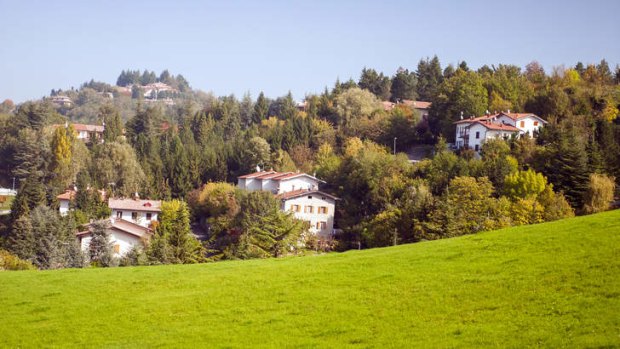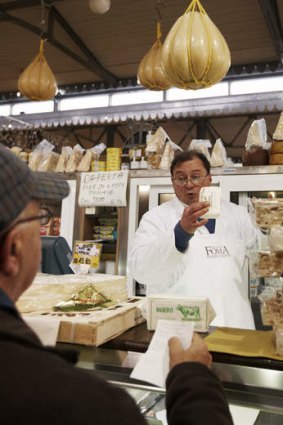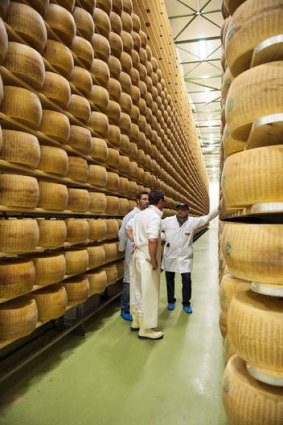
The landscape around the Caseificio Rosola dairy.Credit: Leisa Tyler
Parmesan in Modena is as good as money, writes Leisa Tyler.
'It's all about the soil, the terroir," declares Igino Morini from the Parmigiano Reggiano Board, the committee overseeing the production of parmesan cheese, throwing open his hands as we hurtle along a narrow country road north of Modena in Emilia-Romagna. It's almost midday and the sun is bathing the rolling hills flecked by forest groves and old stone barns in a warm light.
Made up of million-year-old silt washed down from the Alps and Apennines, Emilia-Romagna's rich, fertile soil gives the milk used to make parmesan its special characteristics, its identita, says Morini, a straight-talking Italian with a shiny hairless head.

Say cheese: a cheese seller in Modena.Credit: Getty Images
Morini and I are on a taste test tour of the parmesan-producing dairies around Modena, a mediaeval town in the Po River Valley that is best known for producing opera singer Luciano Pavarotti and car manufacturer Enzo Ferrari. But also home to parmesan, aged balsamic and arguably Italy's most famous chef, Massimo Bottura, it is Modena's culinary credentials that I have come to experience.
Next on our list is Caseificio Rosola, a 100-head dairy that makes parmesan cheese using milk from the Bianca Modenese, a breed of white cow that has recently hit the endangered list. White cows were once prevalent in Modena; 100 years ago they tallied more than 50,000. Now there are a few hundred left, their numbers dwindling with the inundation of more-productive breeds easier to handle in mechanised dairies.
Although still distinctly parmesan, with its crumbly texture filled with crystals and a savoury, tangy edge, Bianca Modenese's cheese is slightly more tart than that produced from other breeds. The 24-month aged cheese has hints of raw milk; the 36-month aged cheese is nuttier, with a palate of leather and spice.

Parmesan cheese in storage.Credit: Leisa Tyler
Known in Italy as Parmigiano Reggiano, parmesan has been produced from these soils since the 13th century. Not long after this it was considered a commodity that could be used as collateral against a loan. Most banks in Modena still have storage space for parmesan; the cheese even has its own stock exchange. Parmesan is protected by the DOP - Denominazione di Origine Protetta, or protected designation of origin trademark - and Italians believe it should only be known as such if the milk comes from a specific part of Emilia-Romagna and hence contains the region's characteristics. The regulations are long: Cows must be fed mainly with local forage. Silage or fermented foods are forbidden, as are animal by-products. The cow must be milked twice a day while she is lactating and that milk must be delivered to the cheese factory no more than two hours later. The only ingredients allowed to make parmesan are milk, salt and rennet.
"The rest is just fraud," Morini says defiantly, quickly adding that there is a lot of fake parmesan in Australia and New Zealand, where dairies ignore parmesan's DOP status and use the name to refer to generic hard cheeses. This same soil is also used to produce Modena's other DOP star, Aceto Balsamico Tradizionale, a glossy, reduced vinegar with both sweet and sour elements that is made from trebbiano and lambrusco grapes and stored for years in a succession of barrels of different woods. Highly prized, this balsamic was once used as dowry in the Modena region.
The practice of producing aged balsamic dates to the Roman era when the technology to extract sugar from cane was still unknown, so balsamic was used as a sweetener, says the sign at the Balsamico Museum in the town of Spilamberto near Modena.
Housed in a late 18th-century mansion, the museum retells the history of this liquid gold and how the DOP product is also rooted in the region's terroir. The top floor holds storage facilities for a series of casks holding the aged vinegar of 20 families; aged balsamic must be stored for a minimum of 12 years before it can be considered the real thing. There is no maximum storage time. The museum has a bottle of aged balsamic from 1785 which it opened 20 years ago. "It was just perfect," museum manager Rino Vecchi says. The museum will open the bottle for another taste test in 30 years.
These DOP products come together in illustrious profundity at Massimo Bottura's fine dining restaurant Osteria Francescana, a smart 12-table diner in Modena's old town. Teaming a strong passion for provenance with innovation (Bottura tells me he is one of a handful of chefs leading a new generation of culinary arts in the world) the degustation menus at Osteria Francescana represent a "journey through Italy" in taste and philosophy. Think eel glazed in Bottura's own aged balsamic that is served with nutty polenta, tart wild apples and a juniper berry beer, a dish exemplifying an eel's journey from the Adriatic Sea to the canals of Modena; Adriatic cod swimming in a very acidic broth of raw tomato, anchovies and pesto; catfish with razor clams in a chlorophyll risotto; a delicate platter of raw mushrooms with radish, parmesan and truffle served with a local spirit with aromas from the forest floor. While most of the flavour combinations work, I get a bit lost in Osteria Francescana's intensity: the convoluted philosophies behind each dish that often take more time to explain than it does to eat; the sombre waiting staff; and the natural beverages chosen not for their drinking pleasure, but to support the food.
More light-hearted is Bottura's newly opened Franceschetta 58, an elongated tapas bar with wall-to-ceiling windows and an upbeat vibe on the outskirts of the old city. Here, tasty but no-frills dishes made from what is available at the market that day and served on mismatched plates cost an affordable €8.50 ($12.30) each.
The food is fresh, simple and down to earth, with dishes such as zucchini flowers stuffed with ricotta, tomato and basil, an extraordinary salad of shredded cabbage with bacon pieces, sliced pear and a tart cheese, lasagne with roasted pumpkin and turnip cubes, and rich and full-bodied baked guineafowl with pear and pumpkin.
But my most memorable Modena dining experience, which could quite well go down as one of the best eats of all time, didn't have a famous chef or slinky decor. Trattoria Bianca, a homely family restaurant by the railway station, has been serving up hearty local fare to Modenesi since 1948. An antipasto of cold cuts, salty melt-in-the-mouth prosciutto that we wrap around bits of gnocchi fritti or deep-fried bread; fat pockets of homemade ravioli stuffed with ricotta and drizzled with a burnt butter and sage sauce; and lashings of tortellini stuffed with pumpkin; all teamed with a bottle of dry, slightly tart local lambrusco and a heavier sangiovese. Bellissimo!
The writer travelled as a guest of the Parmigiano Reggiano Board.
TRIP NOTES
MORE INFORMATION
GETTING THERE
British Airways has a fare to Modena for about $1980, low-season return, economy class, from Sydney including taxes. Fly to London Heathrow Airport (about 24hr via Singapore) and then to Bologna (2hr 5min); see britishairways.com. There are regular trains to Modena taking about 20 minutes.
STAYING THERE
Hotel Cervetta 5 has 22 simple but cosy rooms, some with balconies, on a central street in the old city; doubles from €125 ($180); see hotelcervetta5.com.
EATING THERE
Osteria Francescana, Via Stella 22, Modena; osteriafrancescana.it.
Franceschetta 58, Via Vignolese 58; franceschetta58.it.
Trattoria Bianca, Via Spaccini 24; +39 0 5931 1524.
Sign up for the Traveller Deals newsletter
Get exclusive travel deals delivered straight to your inbox. Sign up now.